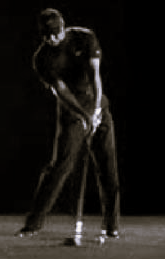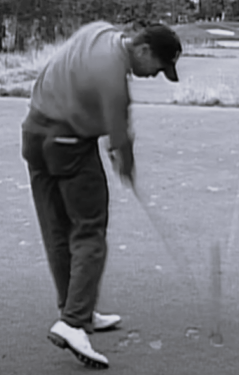Detail 5 Impact Zone
The club head speed at impact is not created by the transferred power from legs to spine to arms, it is created by the centripetal force which is the result of the whole body’s explosive actions at the moment of impact zone.
This means that all powers focus on impact moment together: torso turning back with restored elastic force, huge centripetal force is created, and the lower body pushing up to against this force with right leg’s turning along the opposite direction of torso to keep balance. All these forces focus on the impact zone, Not meaning the power is transferred from lower body to hips to torso to arms to wrists to club… Let’s see what Mr.Jones talked about the impact:
“It is often urged that a person playing golf who worries about how to take the club back, how to start it down and what to do at this stage and at that, ultimately loses sight of the only important thing he has to do— to hit the ball. We, who write on the game and attempt to teach it, are told often enough that we should give more attention to the contact stage and less to the detail of the preparatory motions.
The downward or hitting stroke is intended to culminate in a well-timed, powerful contact between clubhead and ball. There is no way to argue that the successful accomplishment of this purpose is not the most important part of the stroke.” — By Bobby Jones
- Body structure at impact zone
- Keep the structure of legs and the spine. Try to keep the upper spine near the center as possible with the stable head when more weight is moving to the left leg. The centrifugal force from the swung arm-club will pull shoulders to the ball at impact. To take this huge pulling force, the spine has to be at the right posture by the support of both legs — left leg as the turning axis and right leg’s pushing up the torso to turn around the axis — this is why the both feet has to push the ground hard during the impact zone to make the upper spine strong, rotating smoothly and keep balance with lower body.
- The structure of arms. First of all, let the arms really hang on shoulders and connect with the upper spine through the scapulars. To really get lag action, feel both elbows pointing to the target during the impact zone. It’s easy for the left elbow, so the key part is on the right elbow. Because the left arm takes a major role to take the pulling force during downswing, the right arm should cooperate with the left arm: try to feel the right elbow lead the whole right arm (the elbow is ahead of the upper arm and the forearm) to the target during the impact zone. Also, feel the arm-structure turning around the whole spine, not just the upper spine: that means applying the whole torso muscles for more power instead of using shoulders only.

2.. Detail of impact zone
- Planting the left heel on the ground firmly as the clubhead into the impact zone is the common key for most great golf players.
- It is much better to make both heels on the ground at the impact zone, compared with the right heel up. You can see this position from the golf swing of Perry, Garcia, Couples…. it is precisely the power position for dealing with the centripetal force at impact.
- After the right foot pushing the torso up to turn left, the right foot should move back or stay during the impact zone. In fact, the right leg is moving along the opposite direction with the upper body’s turn during the impact zone for keeping the whole body balanced and give the upper body the safety to swing faster — this is a natural action and you don’t have to try to act this way but also do not stop this happen (See chapter 6 for detail). Couples, Perry and Mcilroy are examples trying to make the right leg down and limit the right heel up a moment just after impact.
- At the impact the head is behind the ball; the hands are ahead of the ball. Because the hands and the head move along the opposite directions, so the hands are ahead over the ball and the head is away and behind the ball. Opposite directions means two ways: hands are to the target and head is away from the target; number two, the arms and hands turning around the spine to left and the head & neck staying at the same position even a little bit to right to keep the pulling force from the upper spine.
3. Feelings during impact zone
During the impact zone, the whole body is moving in a dynamic balance; so the legs, pelvic, spine and shoulders are taking huge force, but the arms, wrists and hands are relatively relaxed.
- Feel the whole spine erecting to take the pulling force from swinging club during impact;
- Feel the superposition happen at the impact.

